StP Fort Mahon

Information
StP Fort Mahon
Details
Batterie 9./H.K.A.R.1245.
4 x R671 [3] casemates (2 remain).
6 x Open emplacements with 15.5cm SHF(f) with a range of 11 Kilometres.
(All removed and replaced by the casemates).
20 x Wellblech ammunition & crew bunkers.
1 x R612 casemate North.
1 x R677 casemate South/East.
1 x R640 casemate for PAK gun (removed).
1 x R636 FCP under construction.
4 x R630 machine gun casemate (2 remain).
4 x 10.5cm Schneider K.331(f).
1 x 3.7cm Pak35/36.
1 x 2cm Flak 30.

R671.

R640.

3 x 10.5cm K.331(f) may have looked something like this.
StP Fort Mahon
Information
StP Fort Mahon
Details
Starting point is at the car park on Avenue de la Plage.
StP Fort Mahon

Information
Fort Mahon Plage
Details
A plan of where I think all the bunkers may have been.

One gun was in an open emplacement.

R636 Fire Control Post under construction.
StP Fort Mahon

1946 Geoportail
Information
StP Fort Mahon
Air-photo of where the two R630 were and a Tobruk.
Details
From the car park, walking into the sand dunes you can reach one of the two R630 casemates.
The R/H is still in position but the L/H version we are not at all sure if its not been removed or covered in sand. The red arrows are the arks of fire of the defending machine guns.

R630 L/H machine gun bunker.

Fortress machine gun fittings.

We start at the main car park in the centre of the town..
StP Fort Mahon
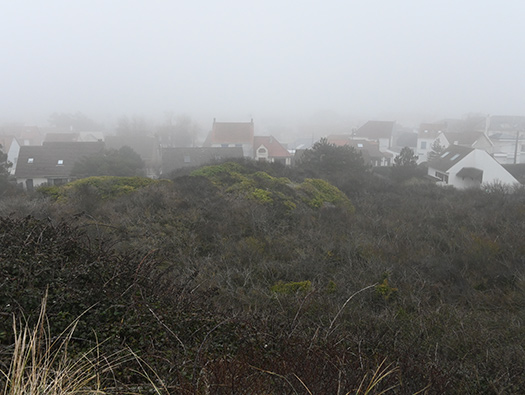
25 January 2020
Information
StP Fort Mahon
R630 roof from behind
Details
In all the undergrowth there is an R630 L/H model. (L/H flanking wall on the left).

Steel plate being fitted.

R630 L/H model machine gun bunker.
StP Fort Mahon
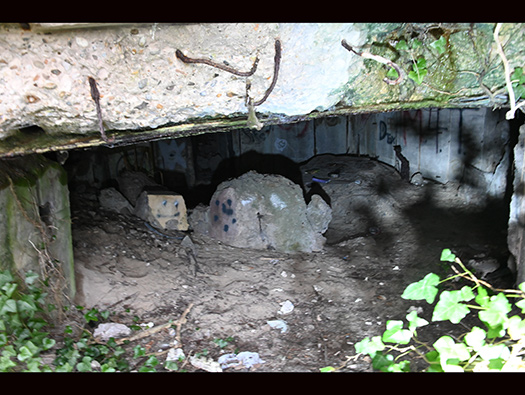
25 January 2020
Information
StP Fort Mahon
R630 gun room.
Details
A very heavy steel plate was bolted to the bunker and then cemented in.

7P7 plate for an R630.

Heavy machine gun inside.

Gun commander looking through his viewing slot.
StP Fort Mahon

25 January 2020
Information
StP Fort Mahon
R630 plate
Details
The bolt fitting set into the main bunker concrete and would have had a large nut and washer to hold it in place. About six would have been used..

A large bolt, this one to hold a steel plate as a roof section but could also be used to hold MG plates.

Early 7P7 plate.
StP Fort Mahon

25 January 2020
Information
StP Fort Mahon
R630 writing on the wall
Details
Nice to see the writing on walls.

Aerial fitting inside a bunker..

Close combat defence embrasure.
StP Fort Mahon

25 January 2020
Information
StP Fort Mahon
R630 gun room
Details
Inside the gun room where a gun commander, a machine gunner and one ammunition bearer would have to work. There was pobably two more men, one using the hand powered fresh air pump. 1. to remove the MG foul smoke from gun room and 2. if there was a gas attack, filter out the gas.

A machine gun room behind a steel plate.

Inside a casemate with a sMG34.

Machine gun fitting.
StP Fort Mahon
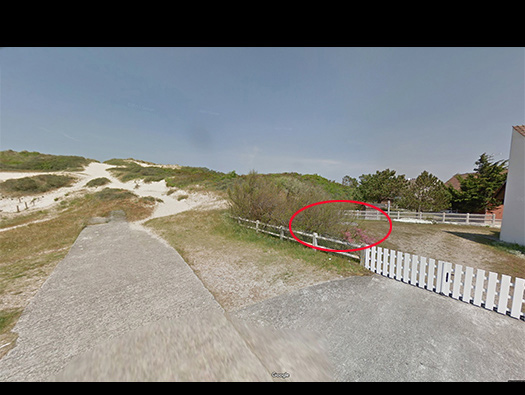
Google
Information
StP Fort Mahon
Tobruk
Details
Possible not a recorded Tobruk in the garden and also the concrete German road. I have only noticed this Tobruk from Google maps and did not visit it.
The road now vanishes under sand dunes, but would have been invaluable to carry heavy materials and equipment to the bunkers in the dunes.
StP Fort Mahon
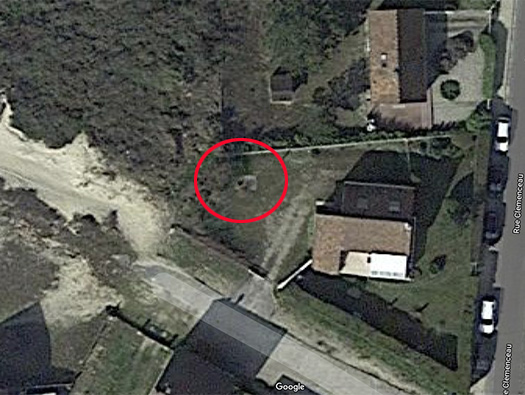
Google
Information
StP Fort Mahon
R630 roof
Details
A Tobruk can be seen in the now garden of the house.

It looks like a Vf58c type.

.
StP Fort Mahon

22 February 2014
Information
StP Fort Mahon
This looks like a Wellblech shelter
Details
Set behind what is now a road running parallel to the sea. These may have been ammunition & crew bunkers for the original batterie of 155 mm SHF414(f) guns with a range of 11 kilometres.

Wellblech.

The position of the Wellblech.

Inside a Wellblech.
StP Fort Mahon
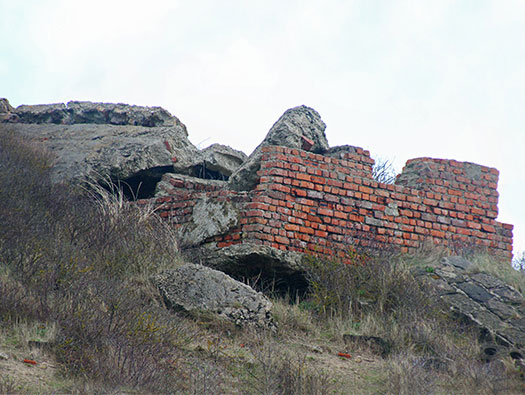
22 February 2014
Information
StP Fort Mahon
This looks like a Wellblech shelter
Details
These could be accommodation for the guns crews and the infantry defence.

Inside a Wellblech.

Inside a rather wet Wellblech in Brittany.
StP Fort Mahon

22 February 2014
Information
StP Fort Mahon
The second Wellblech shelter
Details
Another Wellblech set into the sand dunes behind the sea front flats.

Plan..
StP Fort Mahon

1970 Geoportail
Information
StP Fort Mahon (North)
2 x R671. Searchlight garage (remains), a tank wall & an R612
R630 & Vf2 Bunker (in red removed)
Details
Walking across the large car park on the beach, the two R671 casemates show up on the sand dunes. Then a walk through the sand dunes and we find an anti-tank wall. Then an R612 facing north.
In red are what look like an R630 and a Vf2a bunker that have been (in red) now removed.

R671 elevation.

671 plan.

4 x 10.5cm K.331(f) may have looked something like this.
StP Fort Mahon

22 February 2014
Information
StP Fort Mahon
2 R671 casemate
Details
The casemates from the car park.
StP Fort Mahon
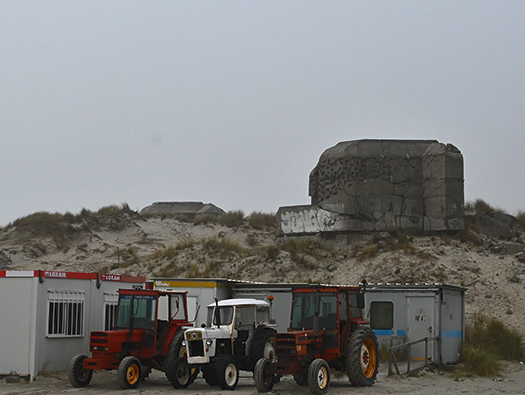
26 January 2020
Information
StP Fort Mahon
Batterie 9./H.K.A.R.1245 4 x 10.5cm K331(f) guns
H.K.A.R - Heers Kusten Artillery Batterie
Details
Here two R671 casemates with 10.5cm guns fitted on a pivot.

Cement bags pushed into the wet cement and removed when dry, creates a depression in the cement. This breaking up the surface and and acts as camouflage.
StP Fort Mahon

22 February 2014
Information
StP Fort Mahon
2 R671 casemate
Details
Here two R671 casemates with 10.5cm guns fitted on a pivot.

The two casemates in the south and the destroyed one in the north.

R671 plan elevation.
StP Fort Mahon

22 February 2014
Information
StP Fort Mahon
R671 casemate Turm 1
Details
Casemate for a pivot mounted 10.5cm K331(f) gun. The gun a French towed artillery piece was mounted on pivot bolted to the floor of the casemate.

Here the gun is on its pivot.

The fourth gun would look like this its 10.5cm K331(f) on a its Lafette. (f) means its a French gun.

10.5cm ammunition.
StP Fort Mahon

22 February 2014
Information
StP Fort Mahon
R671 casemate Turm 1
Details
A very heavy mantle in front of the gun position. In an Allied landing situation, these guns would have played havoc with the ships, landing craft and tanks.

10.5cm casemates, the north one has been removed and the fourth was not built.
StP Fort Mahon

22 February 2014
Information
StP Fort Mahon
R671 casemate Turm 1
Details
The view the other side.
StP Fort Mahon
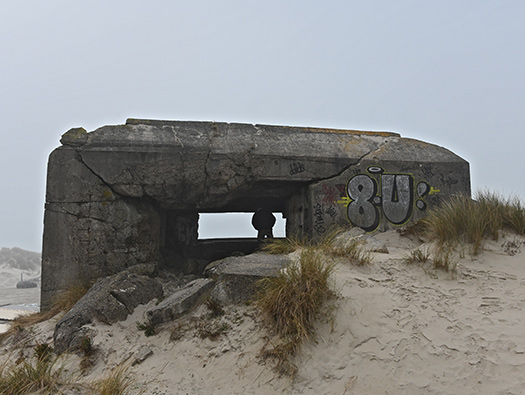
22 February 2014
Information
StP Fort Mahon
R671 casemate Turm 1
Details
The rear entrance.

3 x 10.5cm K.331(f) may have looked something like this.
StP Fort Mahon

22 February 2014
Information
StP Fort Mahon
R671 casemate Turm 1
Details
The rear entrance where there should have been two heavy doors to close off the rear. These often were not fitted before D-day came along.

494P2 doors that may have been used here?

494P2 doors that may have been used here?
StP Fort Mahon

22 February 2014
Information
StP Fort Mahon
R671 casemate Turm 1
Details
Gun room view.
StP Fort Mahon
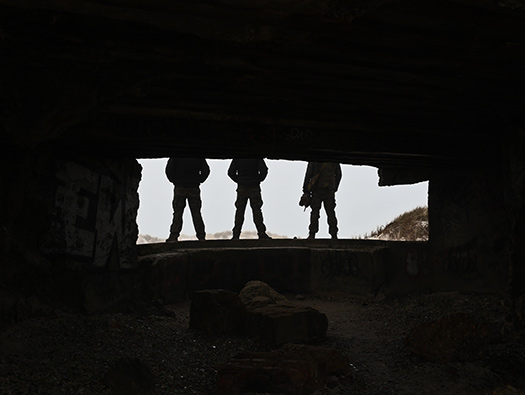
25 January 2020
Information
StP Fort Mahon
R671 casemate Turm 1
Details
Gun room view with MKB Bunker tour 2020.
StP Fort Mahon

22 February 2014
Information
StP Fort Mahon
R671 casemate Turm 1
Details
Looking out of the rear door with John.
StP Fort Mahon

22 February 2014
Information
StP Fort Mahon
R671 casemate Turm 2
Details
Hidden above in the dune.
StP Fort Mahon

22 February 2014
Information
StP Fort Mahon
R671 casemate Turm 2
Details
The path to the rear door.
StP Fort Mahon

22 February 2014
Information
StP Fort Mahon
R671 casemate Turm 2
Details
Small ammunition niche.

There are two niches, one would be for the shells and the other the brass case.

Brass cases stacked up.
StP Fort Mahon

22 February 2014
Information
StP Fort Mahon
R671 casemate Turm 2
Details
Gun room.
StP Fort Mahon

22 February 2014
Information
StP Fort Mahon
R671 casemate Turm 2
Details
Exhaust pipe to remove fumes from the gun room.

This is the plan of an R669 showing how the extraction pipe were set into the concrete.
StP Fort Mahon

22 February 2014
Information
StP Fort Mahon
R671 casemate Turm 2
Details
Looking out to sea.
StP Fort Mahon

25 January 2020
Information
StP Fort Mahon
R671 casemate Turm 2
Details
2020 visit the sand has filled it a bit more..
StP Fort Mahon

22 February 2014
Information
StP Fort Mahon
Battery position
Details
View from above.

Plan.
StP Fort Mahon

22 February 2014
Information
StP Fort Mahon
R671 casemate & garage
Details
Search light shelter garage.

Search light

Search light from an allied plan.

Search light garage on Utah Beach.
StP Fort Mahon

22 February 2014
Information
StP Fort Mahon
Down on the beach in 1970
Details
There was an R630 machine gun casemate facing north up the beach with a Vf2a (maybe) crew quarters.

R630 bunker with a large steel plate for a heavy machine gun.

Vf2a small bunker for a few men.

R630 steel plate.
StP Fort Mahon

22 February 2014
Information
StP Fort Mahon
Battery position
Details
Possible OB for a field gun.

OB ringstand for a field gun.

OB ringstand for a field gun.
StP Fort Mahon

1947
Information
StP Fort Mahon
Battery position
Details
Bomb crater, 04 June 1944 the American Air Force bombed this coastline and then on the morning of 6th June 1944 they bombed the Normandy beaches..

USAAF loading up bombs.

R640 on the beach now removed.

Two R630 bunkers covering the back of the village and may be built over. I think when we did see one from the road.
StP Fort Mahon

25 January 2020
Information
StP Fort Mahon
Battery position
Details
There is quite a lot of concrete remains laying around.
StP Fort Mahon

25 January 2020
Information
StP Fort Mahon
Anti-tank wall
Details
Anti-tank wall in the middle of sand dunes. Trying to understand why an anti-tank wall is placed between two sand dunes, but we are seeing it 77 years later.

Anti-tank wall.

Cross section of a tank wall.
StP Fort Mahon

25 January 2020
Information
StP Fort Mahon
Anti-tank wall
Details
MKB Bunkertour members attempting to cross the wall.
StP Fort Mahon

25 January 2020
Information
StP Fort Mahon
R612 casemate
Details
It was a hard walk accross the sand dunes to get here.

R640 on the beach now removed.
StP Fort Mahon

25 January 2020
Information
StP Fort Mahon
R612 casemate
Details
Rear entrance of the R612.

An R612 was designed to take a field gun of 7.5cm size, it has a flanking wall on the seaward side to protect the guns embrasure.

7.5cm Field Kannon.
StP Fort Mahon

25 January 2020
Information
StP Fort Mahon
R612 casemate
Details
Note the flanking wall.

R612 casemate gun room with two ammunition niches each side.

7.5cm ammunition.
StP Fort Mahon

25 January 2020
Information
StP Fort Mahon
R612 casemate
Details
Looking into the gun room now full of sand.

Gun room..

The area of the R612 and the tank-wall.
StP Fort Mahon

25 January 2020
Information
StP Fort Mahon
R612 casemate
Details
Right hand ammunition niche.

Plan of an R612 casemate..
StP Fort Mahon

25 January 2020
Information
StP Fort Mahon
R612 casemate
Details
When the gun fires, a fan is switched on and sucks out the foul air from the gun room via this armoured vent.

The venting pipes to remove foul air from the casemate.

Rost 200mm..
StP Fort Mahon

25 January 2020
Information
StP Fort Mahon
R612 casemate
Details
The sand dunes are moving all the time and the front of the casemate has been completely covered over.
StP Fort Mahon

25 January 2020
Information
StP Fort Mahon
Back on the beach
Details
StP Fort Mahon

25 January 2020
Information
StP Fort Mahon
Back on the beach
Details
StP Fort Mahon

1946 Geoportail
Information
StP Fort Mahon
R630 -------------- R640
Details
At the end of this road and set on the promenades an R640 casemate for the 3.7cm Pak35/36.
This other end an R630 machine gun casemate..

I think this is the R640 that was on the beach.

3.7cm Pak35/36.

R640
StP Fort Mahon

22 February 2014
Information
StP Fort Mahon
Details
At the end of this road and set on the promenades an R640 casemate for the 3.7cm Pak35/36.
StP Fort Mahon


Geoportail 1946
Information
StP Fort Mahon
Back to the town
Rommel´s Asparagus
Details
Here they have been removed off the beach and dumped. Also many wooden stakes.
StP Fort Mahon

22 February 2014
Information
StP Fort Mahon
R630 roof
Details
Looking down the beach note the aerial fittings on the other-side of the fence.

Plan.

Aerial fitting inside a bunker..

Bunker radio.
StP Fort Mahon

22 February 2014
Information
StP Fort Mahon
Now the southern end of the beach
Details
At the end of this row houses is the R630 a machine gun casemate with an armoured plate.

Plan of an R630.

Plan of an R640 from an Allied drawn plan.

The type of metal plate that would have been used to cover the embrasure.
StP Fort Mahon

22 February 2014
Information
StP Fort Mahon
R630 looking into the embrasure with its flanking wall on the left side and a Tobruk defence
Details
At the end of this row houses is the R630 a machine gun casemate with an armoured plate.

Plan of an R630.

Inside a crew room of a bunker.

Bunker machine gun fitting..
StP Fort Mahon

22 February 2014
Information
StP Fort Mahon
The Tobruk defence
Details
The Tobruk allows 360degree view around the bunker and can even be used as an anti-aircraft role.

Tobruk.

An allied plan of a Tobruk.

This is a 1946 air photo of the R630 with no houses about.
StP Fort Mahon

22 February 2014
Information
StP Fort Mahon
R 630 side view
Details
There are some memorials on the side of this bunker.
StP Fort Mahon

22 February 2014
Information
StP Fort Mahon
Memorial
Details
A PLAQUE remembering five French soldiers who crossed the English Channel in canoes to join the British war effort has been unveiled at Beachy Head.
The five young men from the French region of Picardie overcame the odds to traverse the 60-mile stretch of sea on September 16, 1941.
The brave soldiers, StP Fort Mahon Plage ..... g bas Reynold Lefebvre, Christian and Guy Richard, and Jean-Paul and Pierre Lavoix, were determined to flee occupied France to fight on with British troops.
Now their heroic efforts have been officially recognised through a special plaque, commissioned by the town of Fort-Mahon Plage, close to where the men set off, and located at Beachy Head.
The Mayors of Eastbourne, Cllr Mike Thompson, and of Fort-Mahon Plage, M Alain Baillet and Mme Yvette Bonnet, joined other dignitaries including Philippe Lavoix, the son of Pierre Lavoix, for the official unveiling.
Two of the five men are still alive. Jean-Paul Lavoix, 88, who lives in Kerlouan (Brittany) broke his leg three months ago and was not able to attend the event while Guy Richard, 87, now lives in the South West of France. Eastbourne Herald news paper.

Local fishermen.
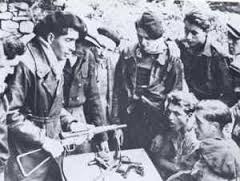
Free French.
StP Fort Mahon

Google
Information
StP Fort Mahon
R677 casemate
Details
Covering the inland southern flank is this R677, we did not visited it.
R677 casemate for an 8.8cm Pak 43/41 holding one of the best German anti-tank guns with phenomenal power and would have taken out any Allied tank, if it had tried to cross in front of it.

8.8cm Pak 43/41.

R677 casemate..

R677 casemate how it may have looked.

Plan.
StP Fort Mahon

26 January 2020
Information
StP Fort Mahon
Details
 Norway (coming soon!)
Norway (coming soon!)
 France
France
 Great Britain
Great Britain

































































































































